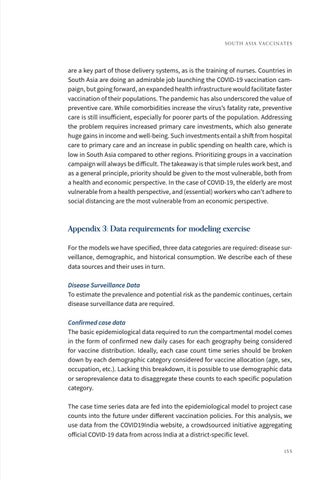S o u t h A s i a Va c c i n a t e s
are a key part of those delivery systems, as is the training of nurses. Countries in South Asia are doing an admirable job launching the COVID-19 vaccination campaign, but going forward, an expanded health infrastructure would facilitate faster vaccination of their populations. The pandemic has also underscored the value of preventive care. While comorbidities increase the virus’s fatality rate, preventive care is still insufficient, especially for poorer parts of the population. Addressing the problem requires increased primary care investments, which also generate huge gains in income and well-being. Such investments entail a shift from hospital care to primary care and an increase in public spending on health care, which is low in South Asia compared to other regions. Prioritizing groups in a vaccination campaign will always be difficult. The takeaway is that simple rules work best, and as a general principle, priority should be given to the most vulnerable, both from a health and economic perspective. In the case of COVID-19, the elderly are most vulnerable from a health perspective, and (essential) workers who can’t adhere to social distancing are the most vulnerable from an economic perspective.
Appendix 3: Data requirements for modeling exercise For the models we have specified, three data categories are required: disease surveillance, demographic, and historical consumption. We describe each of these data sources and their uses in turn. Disease Surveillance Data To estimate the prevalence and potential risk as the pandemic continues, certain disease surveillance data are required. Confirmed case data The basic epidemiological data required to run the compartmental model comes in the form of confirmed new daily cases for each geography being considered for vaccine distribution. Ideally, each case count time series should be broken down by each demographic category considered for vaccine allocation (age, sex, occupation, etc.). Lacking this breakdown, it is possible to use demographic data or seroprevalence data to disaggregate these counts to each specific population category. The case time series data are fed into the epidemiological model to project case counts into the future under different vaccination policies. For this analysis, we use data from the COVID19India website, a crowdsourced initiative aggregating official COVID-19 data from across India at a district-specific level. 155




